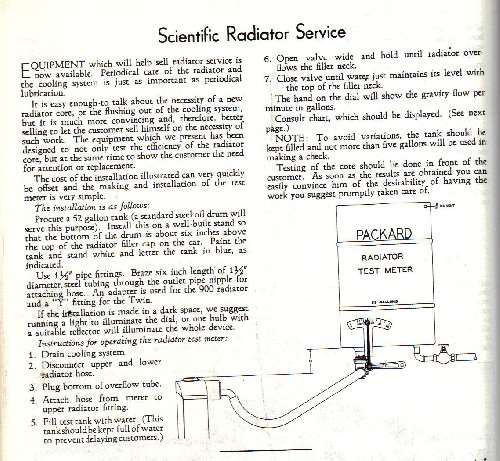Re: Anyone develop a radiator flow test without removing it?
Posted by Owen_Dyneto On 2014/11/6 10:22:29
Maybe I'm missing something here - no need to remove thre radiator from the car that I'm aware of; I've done but a few gravity flow rate tests on radiators and have done them with the radiator mounted in the car.
Hoist a 50 gallon steel drum such that the base is a foot or less above the upper radiator tank and fix the outlet of the drum with a valve and hose going into the top radiator tank. The valve should be a large bore (1-1/2" or so) and as large a hose as will fit into the radiator gooseneck. Remove the lower radiator hose. Put 36 gallons of water into the tank (or half as much if you want to time it for 30 seconds which would allow you to use a smaller drum), start your clock and open the valve. You may have to modulate the valve if the overhead tank delivers faster than the radiator can pass the water; just adjust the valve constantly so as to loose as little water as possible at the filler, yet not allowing the top radiator tank to go dry - that's the key to getting a valid test, along with having a tank valve and hose that can deliver (with the valve fully open) water faster than the radiator can pass it. You don't want to seal the joint between the tank and radiator gooseneck as the test is for "gravity" flow rate and trying to seal the connection at the radiator fill point would add a pressure from the head of the water in the tank.
There is a decent illustration of this in one of the Packard service documents, if I run across it today I'll add it here.
PS - here's the method shown in the Service Letters. As you can see the radiator has not been removed from the car. The difference with this method is that the valve has a scale which gives the flow rate; without that little device you will have to time how long it takes to pass the specified number of gallons. Note that they use a flange mounted to the shutter thermostat opening rather than filling thru the radiator cap opening - making that little flange would make doing the test much simplier and neater for you - just modulate the valve to keep the top tank filled.
Hope this helps - it's a messy little job but is the best way to evaluate the cooling capacity of a radiator core.
Attach file:
 (211.30 KB)
(211.30 KB)

Hoist a 50 gallon steel drum such that the base is a foot or less above the upper radiator tank and fix the outlet of the drum with a valve and hose going into the top radiator tank. The valve should be a large bore (1-1/2" or so) and as large a hose as will fit into the radiator gooseneck. Remove the lower radiator hose. Put 36 gallons of water into the tank (or half as much if you want to time it for 30 seconds which would allow you to use a smaller drum), start your clock and open the valve. You may have to modulate the valve if the overhead tank delivers faster than the radiator can pass the water; just adjust the valve constantly so as to loose as little water as possible at the filler, yet not allowing the top radiator tank to go dry - that's the key to getting a valid test, along with having a tank valve and hose that can deliver (with the valve fully open) water faster than the radiator can pass it. You don't want to seal the joint between the tank and radiator gooseneck as the test is for "gravity" flow rate and trying to seal the connection at the radiator fill point would add a pressure from the head of the water in the tank.
There is a decent illustration of this in one of the Packard service documents, if I run across it today I'll add it here.
PS - here's the method shown in the Service Letters. As you can see the radiator has not been removed from the car. The difference with this method is that the valve has a scale which gives the flow rate; without that little device you will have to time how long it takes to pass the specified number of gallons. Note that they use a flange mounted to the shutter thermostat opening rather than filling thru the radiator cap opening - making that little flange would make doing the test much simplier and neater for you - just modulate the valve to keep the top tank filled.
Hope this helps - it's a messy little job but is the best way to evaluate the cooling capacity of a radiator core.
Attach file:
 (211.30 KB)
(211.30 KB)
This Post was from: https://packardinfo.com/xoops/html/modules/newbb/viewtopic.php?post_id=152625